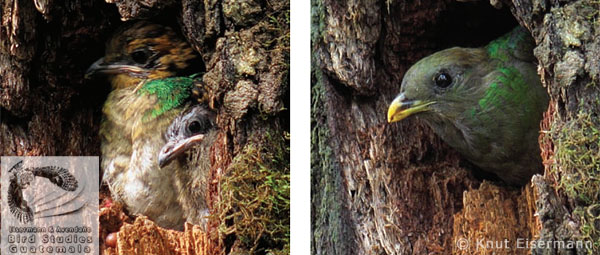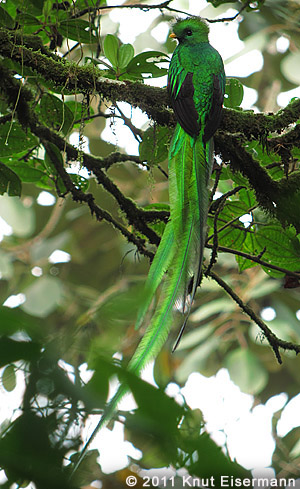Historia natural del Quetzal (Pharomachrus mocinno)

Knut Eisermann apoya investigaciones sobre la morfología y ecología de anidación del Quetzal, en conjunto con la Universidad de Ciencias Aplicadas Eberswalde. Los siguientes artículos han sido publicados:
Eisermann, K. (2013) Noteworthy nesting record and unusual bill coloration of Resplendent Quetzal Pharomachrus mocinno. Cotinga 35: 76-80.
Schulz, U. & K. Eisermann (2017) Morphometric differentiation between subspecies of Resplendent Quetzal (Pharomachrus mocinno mocinno and P. m. costaricensis) based on male uppertail-coverts. Bulletin of the British Ornithologists' Club 137: 287-291.
Abstract: Resplendent Quetzal Pharomachrus mocinno is endemic to montane
cloud forests of Middle America. Disjunct populations in the highlands north
(southern Mexico and northern Central America) and south of the lowlands of
Nicaragua (Costa Rica and Panama) have been recognised subspecifically by
several authorities (e.g. Ridgway 1911, Cory 1919, Dickinson & Remsen 2013, Gill
& Donsker 2017), but have also been suggested to merit species status (Solórzano
& Oyama 2010). We present morphometric differences in the elongated uppertail-coverts
of adult males. We analysed width and length of the uppertail-coverts of
73 adult male specimens in European ornithological collections. Mean width and
mean length of the uppertail-coverts were significantly greater in northern P. m.
mocinno compared to southern P. m. costaricensis. Our data support a previously
published proposal to treat the two taxa as species based on molecular and other
morphological data.
Datos preliminarios fueron publicados en: Schulz, U. & K. Eisermann (2012) Morphologische Unterscheidung von Guatemala-Quetzal Pharomachrus mocinno und Costa-Rica-Quetzal P. costaricensis anhand der Schmuckfedern. Ornithologischer Anzeiger 51: 70-74.
